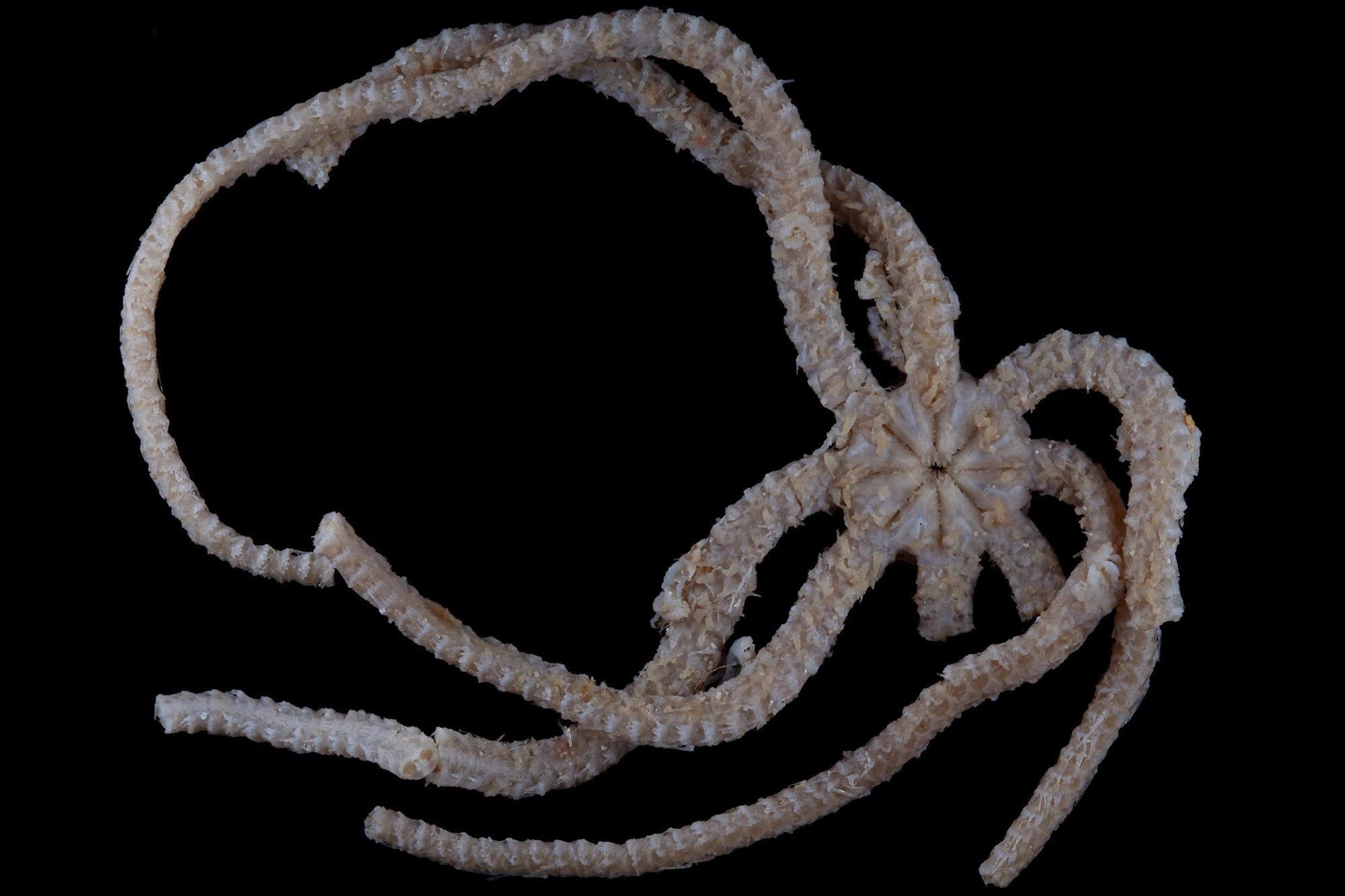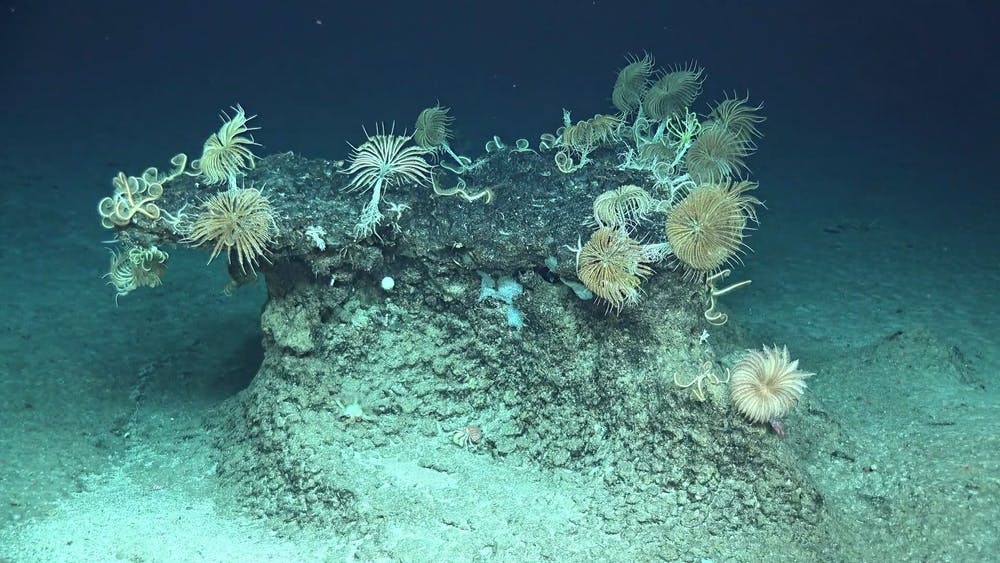Ophiojura - 8-legged starfish full of long, snake-like spines, 8 sets of jaws with sharp teeth
It is the first and only specimen of Ophiojura to date. And now it has been scientifically described in a new study. Ophiojura is a brittle starfish, also known as snake-tailed starfish, which is a distant relative of starfish, with eight snake-like legs radiating from its body.

Close-up photo of Ophiojura's 8 toothed jaws
Eight legs, each wing is 10cm long and the top is covered with rows of hooks and spikes, and lots of sharp teeth on the 8 teeth! A microscopic scan shows rows of sharp teeth growing in every jaw used to trap and tear prey. This is an animal like from a nightmare.

Ophiojura truly represents a completely unique and never-before-seen type of animal. It is one of the last known species of an ancient lineage.
Compare DNA from a range of different marine species and the scientists concluded that Ophiojura diverged from its closest living starfish relative in about 180 million years of evolution. This means that their most recent common ancestor lived during the Triassic or early Jurassic, when dinosaurs were just emerging. Over the past 180 million years, Ophiojura has continued to evolve, albeit very small and barely noticeable.

For life on the seafloor, the center of paleontological endemism lies on the continental margins and subterranean mountains in tropical seas from 200 meters to 1,000 meters deep. This is where we find the "support" of ancient sea creatures - species that have existed in a relatively primitive form for millions of years.

Subterranean mountains, like the one in which Ophiojura is found, are usually submerged volcanoes created millions of years ago. Lava flows from vents on the seafloor, continuously creating more layers of basalt to the top of the volcano. Volcanoes can rise out of the sea, forming an island volcano like those in Hawaii, sometimes with coral reefs surrounding its shores.
But eventually the volcano dies, the heavy basalt causes the mountain to sink into the relatively soft oceanic crust. Given enough time, the subterranean mountain would sink hundreds or even thousands of meters below sea level and gradually become covered again in deep-sea fauna.
You should read it
- 30 creative templates make viewers unable to take their eyes off
- How to share files unlimitedly on Tresorit Send
- Instructions to download the black fire transformer application is causing fever on Facebook
- Dell denied rumors of 'XPS' death
- The lesson draws from interesting stories about Google penalties and dirty SEO
- Instructions to reset Windows Firewall Rules to the initial default state
- Top 7 foods that help reduce blood cholesterol best
- How to fix 'An app default was reset' error on Windows 10
May be interested
- Starfish can walk at a speed of 1 m / min, and this is how they move
 a mature sunflower starfish can move at a rate of 1m per minute.
a mature sunflower starfish can move at a rate of 1m per minute. - 4 habits unknowingly make teeth more and more badly damaged
 broken teeth not only affect aesthetics but also greatly affect the overall health.grandparents often have the phrase "the hair is the corner of a human hair", this is not true. it can be seen that people from ancient times attach great importance to teeth and hair.
broken teeth not only affect aesthetics but also greatly affect the overall health.grandparents often have the phrase "the hair is the corner of a human hair", this is not true. it can be seen that people from ancient times attach great importance to teeth and hair. - Working hot on the screen, sneaking out on Facebook, have you tried it?
 'snakes crawling out of the screen' on facebook is a new trend that has emerged recently. when users install the snake application on the screen of joke on android, a snake will appear on the facebook interface.
'snakes crawling out of the screen' on facebook is a new trend that has emerged recently. when users install the snake application on the screen of joke on android, a snake will appear on the facebook interface. - The death bite of the snake with the longest fangs
 video recorded a scene of a gaboon viper possessing fangs up to 5cm long hunting prey.
video recorded a scene of a gaboon viper possessing fangs up to 5cm long hunting prey. - Brush Unico mouthpiece is claimed to brush teeth clean in just 3 seconds
 back in july, we learned about the amabrush, a tool that cleans all teeth in just 10 seconds. for many people, they feel the tool works for a long time, so recently, unico, a smart smart tube that is supposed to be brushed in just three seconds is about to be released.
back in july, we learned about the amabrush, a tool that cleans all teeth in just 10 seconds. for many people, they feel the tool works for a long time, so recently, unico, a smart smart tube that is supposed to be brushed in just three seconds is about to be released. - 'Falling' with the reason why birds don't have teeth
 even snails possess a huge number of teeth up to 15,000. so why don't birds own any teeth while they have very hard beaks?
even snails possess a huge number of teeth up to 15,000. so why don't birds own any teeth while they have very hard beaks? - The dentist instructs how to brush teeth properly
 brushing your teeth properly helps you reduce the risk of dental diseases such as tooth decay, gingivitis, etc. conversely, if you brush your teeth the wrong way but do not clean your teeth but also wear away the enamel layer, damage gums, gingivitis and gum recession. so, how to properly brush and brush teeth?
brushing your teeth properly helps you reduce the risk of dental diseases such as tooth decay, gingivitis, etc. conversely, if you brush your teeth the wrong way but do not clean your teeth but also wear away the enamel layer, damage gums, gingivitis and gum recession. so, how to properly brush and brush teeth? - Should I brush my teeth before or after breakfast?
 brushing your teeth in the morning is more than just fresh breath; it's an important part of protecting your oral and overall health. but do you know whether you should brush your teeth before or after breakfast?
brushing your teeth in the morning is more than just fresh breath; it's an important part of protecting your oral and overall health. but do you know whether you should brush your teeth before or after breakfast? - 5 surprising facts about 'Queen of the ocean floor': Starfish
 as one of the 'ocean floor queen', starfish contains 5 interesting facts that no one shivers.
as one of the 'ocean floor queen', starfish contains 5 interesting facts that no one shivers. - How to whiten yellow teeth at home quickly and effectively
 let's discover the ways to whiten yellow teeth at home quickly and effectively to have a bright, confident smile!
let's discover the ways to whiten yellow teeth at home quickly and effectively to have a bright, confident smile!










 Octopuses are very intelligent, they can become candidates for the position of 'ruling the Earth' when humans are no more.
Octopuses are very intelligent, they can become candidates for the position of 'ruling the Earth' when humans are no more. 10 sounds that make people feel the most uncomfortable
10 sounds that make people feel the most uncomfortable Discovered a potential glacier near the surface of Mars, suitable as a base for future astronauts
Discovered a potential glacier near the surface of Mars, suitable as a base for future astronauts Deciphering the mystery of consciousness, the human brain can work in 11 dimensions
Deciphering the mystery of consciousness, the human brain can work in 11 dimensions Why do we have beards? While beards are completely biologically useless
Why do we have beards? While beards are completely biologically useless The truth is full of surprises behind the legendary background image of Windows XP
The truth is full of surprises behind the legendary background image of Windows XP